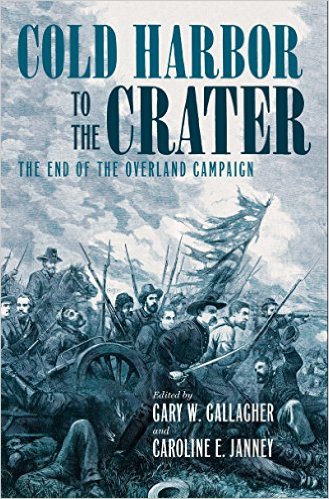Cold Harbor to the Crater: The End of the Overland Campaign edited by Gary W. Gallagher and Caroline E. Janney. University of North Carolina Press, 2015. Cloth, ISBN: 978-1-4696-2533-1. $35.00.
 Civil War histories have often brushed past the Overland Campaign, summing it up with simplistic illustrations of vast casualties on both sides as the northern and southern armies maneuvered themselves slowly toward the trenches at Petersburg and the inevitable end to the American Civil War. Cold Harbor to the Crater, ten essays collected within the tenth volume in the Military Campaigns of the Civil War series, offers a concise, approachable view of the end of the Overland Campaign, introducing several thoughtful examples of just how uncertain the war’s outcome remained in 1864.
Civil War histories have often brushed past the Overland Campaign, summing it up with simplistic illustrations of vast casualties on both sides as the northern and southern armies maneuvered themselves slowly toward the trenches at Petersburg and the inevitable end to the American Civil War. Cold Harbor to the Crater, ten essays collected within the tenth volume in the Military Campaigns of the Civil War series, offers a concise, approachable view of the end of the Overland Campaign, introducing several thoughtful examples of just how uncertain the war’s outcome remained in 1864.
One of the editors of this collection, Gary W. Gallagher, provides his own thoughts in an essay about how the soldiers and the public viewed Grant and Lee in light of the escalating casualties of this campaign. As their armies maneuvered around one another, both generals came under fire both at home and abroad. Robert E. L. Krick’s examination of the reinforcement of the Army of Northern Virginia does an excellent job of exploring the challenges faced by Lee as he attempted to gather as many soldiers as he could from across the Confederacy. Despite many challenges, the government succeeded in helping Lee to maintain his pre-campaign strength, allowing the continuation of the war into 1865.
Kathryn Shively Meier provides one of the most interesting narratives of this collection by illustrating the ways in which soldiers persevered despite the extreme losses, hard marches, and environmental challenges that they faced in the swamps of eastern Virginia. As she details, the soldiers developed methods of coping with their harsh reality in an extraordinary fashion, allowing them to push forward and ensuring that the outcome of the war would not be decided so easily. Along similar lines, M. Keith Harris explores the morale of the soldiers entrenched around Petersburg when the movement finally ground to a halt. Here, Harris pushes the scholarship forward, refuting previous historians who have suggested that the end of the war was simply a waiting game and the downfall of the Confederacy would be inevitable. Harris illustrates that, generally speaking, Confederate spirits remained high into 1865 and most individual soldiers expressed a belief that they held the potential destruction of the Union army within their grasp.
Caroline E. Janney explores the civilian experience and reaches similar conclusions to both Meier and Harris. Despite controversial Union shelling efforts that put the inhabitants of Petersburg at risk, and with supplies running low, southerners behind Confederate lines remained upbeat and defiant. Many of Petersburg’s denizens felt that the total war unleashed against them resulted in unnecessary casualties among both white and black residents. Citizens, however, remained steadfast and determined not to surrender their town, pointing to Vicksburg and New Orleans as examples of cities that gave up too easily.
The last two essays by Kevin M. Levin and Stephen Cushman respectively explore the role and portrayal of the experience of black soldiers in the Union army, focused mainly around the conflict at the Crater. Southerners saw the Crater as the moment when the war changed because they observed northerners arming former slaves and encouraging them to fight against the slaveholding class. Unfortunately, many southern soldiers responded with unmitigated violence, killing many black soldiers who had already surrendered. Cushman explores the ways in which writers have portrayed this battle and the use of black soldiers. He provides, in this essay, an excellent model for the examination of fictional sources for their ability to tell a story to a wider audience, and if the author so chooses, within the realm of historical accuracy.
The combination of these ten essays, by leading scholars in our field, provides a successful examination of the end of the Overland Campaign. Several of the essays break new ground and hint at unique approaches for future scholarship. While not as detailed as one might seek for the purpose of military or tactical history, these works absolutely provide a well-executed framework for many different topics—from trench warfare and the reinforcement of Lee’s army, to the trials and tribulations of soldiers in the trenches and the civilians behind Confederate lines. This collection will certainly provide a useful text for those looking for brief synopses of various topics. Nor should the value of the bibliographical work in each essay be understated.
Nate Buman received his Ph.D. from Louisiana State University and is currently employed as the Manager of the Shelby County Historical Museum in Harlan, Iowa. Buman is the former editor of the Civil War Book Review.